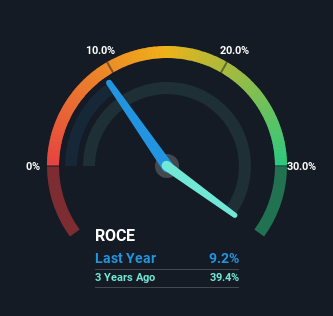If you're looking for a multi-bagger, there's a few things to keep an eye out for. Firstly, we'll want to see a proven return on capital employed (ROCE) that is increasing, and secondly, an expanding base of capital employed. Ultimately, this demonstrates that it's a business that is reinvesting profits at increasing rates of return. However, after investigating S-Pool (TSE:2471), we don't think it's current trends fit the mold of a multi-bagger.
Return On Capital Employed (ROCE): What Is It?
For those who don't know, ROCE is a measure of a company's yearly pre-tax profit (its return), relative to the capital employed in the business. To calculate this metric for S-Pool, this is the formula:
Return on Capital Employed = Earnings Before Interest and Tax (EBIT) ÷ (Total Assets - Current Liabilities)
0.092 = JP¥2.2b ÷ (JP¥34b - JP¥9.4b) (Based on the trailing twelve months to February 2024).
So, S-Pool has an ROCE of 9.2%. Ultimately, that's a low return and it under-performs the Professional Services industry average of 15%.
See our latest analysis for S-Pool

Above you can see how the current ROCE for S-Pool compares to its prior returns on capital, but there's only so much you can tell from the past. If you'd like to see what analysts are forecasting going forward, you should check out our free analyst report for S-Pool .
What The Trend Of ROCE Can Tell Us
On the surface, the trend of ROCE at S-Pool doesn't inspire confidence. Around five years ago the returns on capital were 41%, but since then they've fallen to 9.2%. However it looks like S-Pool might be reinvesting for long term growth because while capital employed has increased, the company's sales haven't changed much in the last 12 months. It may take some time before the company starts to see any change in earnings from these investments.
On a related note, S-Pool has decreased its current liabilities to 28% of total assets. That could partly explain why the ROCE has dropped. What's more, this can reduce some aspects of risk to the business because now the company's suppliers or short-term creditors are funding less of its operations. Some would claim this reduces the business' efficiency at generating ROCE since it is now funding more of the operations with its own money.
The Bottom Line
To conclude, we've found that S-Pool is reinvesting in the business, but returns have been falling. And investors appear hesitant that the trends will pick up because the stock has fallen 37% in the last five years. Therefore based on the analysis done in this article, we don't think S-Pool has the makings of a multi-bagger.
If you'd like to know about the risks facing S-Pool, we've discovered 2 warning signs that you should be aware of.
While S-Pool isn't earning the highest return, check out this free list of companies that are earning high returns on equity with solid balance sheets.
New: Manage All Your Stock Portfolios in One Place
We've created the ultimate portfolio companion for stock investors, and it's free.
• Connect an unlimited number of Portfolios and see your total in one currency
• Be alerted to new Warning Signs or Risks via email or mobile
• Track the Fair Value of your stocks
Have feedback on this article? Concerned about the content? Get in touch with us directly. Alternatively, email editorial-team (at) simplywallst.com.
This article by Simply Wall St is general in nature. We provide commentary based on historical data and analyst forecasts only using an unbiased methodology and our articles are not intended to be financial advice. It does not constitute a recommendation to buy or sell any stock, and does not take account of your objectives, or your financial situation. We aim to bring you long-term focused analysis driven by fundamental data. Note that our analysis may not factor in the latest price-sensitive company announcements or qualitative material. Simply Wall St has no position in any stocks mentioned.
About TSE:2471
Solid track record established dividend payer.
Market Insights
Community Narratives



